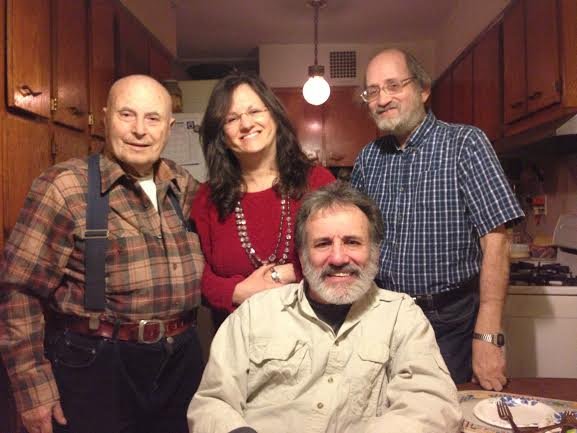IN THE 1960s

At lunch with his family after our friend Louie Weber’s tombstone unveiling on Long Island, his niece brought a box of his photos. In the pile, I found one picture of my parents with my brother Stu and me from August 1964 and a few other gems.
My brothers Al and Stu were there that day to honor Louie’s memory. Over the years, my brothers came to Brooklyn with me to visit the photographer of that coveted photo, our dear friend Louie.
Tens years earlier, my husband snapped another classic picture. That time Louie was in the picture. It was after our parents, of blessed memory, were no longer living.
March 2013 Louie, Sharon, Stu standing, Al is seated Stu and I are in the picture from August 1964 with our parents…photo credit on that one was Louie, on this one, my husband Arnee
I’ve written about Louie in my blog posts several times over the years since the passing of my parents and articles I’ve written about him have been published in newspapers. Louie and his wife Sarah were dear family friends who brought joy and exploration.
Whether I was 11 or younger, or 60 or older, I can never tire of those precious memories from my early days, later days, or the years between. As the Yizkor prayers*, which we just recited on Yom Kippur remind us, when we remember our loved ones who have passed away, “they are a part of me.”
This year erev** Yom Kippur fell on October 11. My brother Stu and I spoke on the phone earlier in the day and remembered dear Louie’s birthday—
Louis Weber, z”l - October 11, 1921 - February 10, 2023
Memorial candles are lit in remembrance on the eve before the holidays and on the anniversary of the death of a loved one
*“Yizkor: The Jewish Memorial Service
“Yizkor is recited four times a year during holiday synagogue services.
“Jewish mourning is both private and public. When we visit a grave or observe a yahrzeit [anniversary of a person’s death], we generally do so in private. Yizkor is the public observance for the community of bereaved.
“Yizkor means ‘may [God] remember,’ from the Hebrew root zachor. It is recited four times a year in the synagogue: on Yom Kippur, Shemini Atzeret, the eighth day of Passover, and the second day of Shavuot. In Israel, it is recited on the combined Simchat Torah /Shemini Atzeret, the seventh day of Passover, and on the only day of Shavuot.
“Originally, Yizkor was recited only on Yom Kippur. Its primary purpose was to honor the deceased by committing to giving tzedakah [charity] in their memory, on the theory that the good deeds of the survivors elevate the souls of the departed. It also enhanced the chances for personal atonement by doing a deed of lovingkindness. Since the Torah reading on the last day of the pilgrimage festivals [the holidays of Sukkot, Passover, and Shavuot] mentions the importance of donations, Yizkor was added to these holiday services as well.
“It was the custom in medieval Germany for each community to read a list of its martyrs at the Yizkor service. The practice was eventually expanded to include the names of other members of the community who had died. Today, most synagogues publish lists of those who are remembered by congregants, which are distributed at the Yizkor services. In addition, the lights on all the memorial tablets in the synagogue are turned on.”
**In the Jewish religion holidays start the evening (erev) before the day of the holiday

